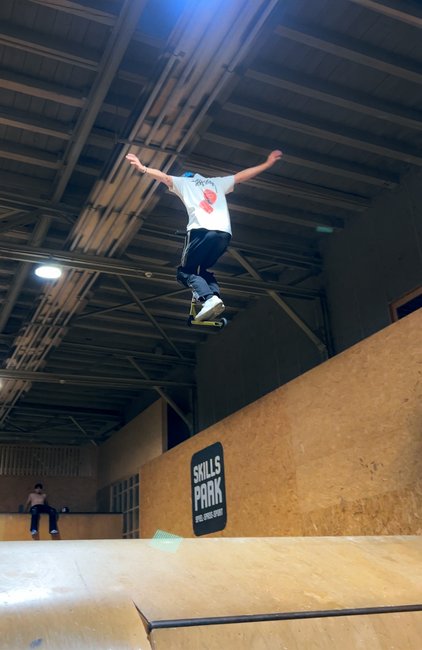
Ready, Scooter, Go! 🚀
For our IT apprentice Felix Jund, scootering is more than just a hobby – it is a passion. This summer, he competed in the World Championships for the first time, demonstrating that dedication and hard work truly pay off!
Here is a little riddle to start – What do the year 1999, a Swiss banker, and scootering have in common? No clue? Then pay close attention. 😉
In 1999, banker Wim Ouboter founded the company Micro Mobility Systems and launched a product that continues to shape urban mobility: the foldable aluminum kick scooter. These sleek, silver "city scooters" quickly became a global sensation, especially among kids and teens.
When Ouboter invented the "Micro Scooter," his focus was on practicality and portability. However, it did not take long for the skateboard and BMX communities to recognize the scooter’s potential for tricks and stunts in skateparks. And so, the extreme sport of scootering was born.
Since its beginnings in the 2000s, the sport has evolved and solidified itself as more than just a trend. At the heart of this adrenaline-fueled scene is Felix Jund, an IT apprentice at RAMPF.
Felix started scootering in elementary school, riding city scooters with friends on half-pipes. Today, it is more than just a hobby – this summer, he competed in the Scootering World Championship for the first time. Passion and determination truly pay off!
In our interview, Felix reveals what fascinates him about scootering, how the community supports one another, and how he prepares for international competitions.
Felix, how does one get started with a sport like scootering? You can't just hop on a scooter, race down a ramp, and start doing tricks, can you?
No, definitely not. We started with regular city scooters, riding around to get a feel for it, then gradually moved on to our first ramps. Tricks weren’t even on our radar at that point – we just wanted to have fun riding the pipe.
How would you explain scootering to a Martian who has never heard of the sport?
A stunt scooter is a small, two-wheeled vehicle specially designed for tricks and big jumps. People stand with both feet on a small platform called the deck that is connected to the handlebar to which you hold on with your hands. With this setup, all kinds of tricks and flips are performed.
The sport looks spectacular – but the risk of injury must be high, right? How often do you hit your shin with the scooter deck while learning new tricks?
The shins took more hits back then than they do now; over time, you gain more control over the scooter. Injuries are, unfortunately, quite normal, with the most common ones being ankle and knee injuries, like ACL tears. I’ve personally overstretched the ligaments in both ankles and broken my fibula and ankle on my right foot. That resulted in a five-month break and three months on crutches.
What kind of scooters do you use? Are they regular "city scooters"?
No, the scooters we use are made of aluminum, except for the handlebar, which is made of a titanium alloy. The wheels are smaller, and it can’t be folded. Our scooters are completely modular, so you usually just replace the part that’s broken. They’re also much sturdier and can take a lot of wear and tear.
Weight is also crucial. In the past, we wanted scooters as light as possible to make tricks easier. But that’s changed in recent years, as a slightly heavier scooter offers more control, allowing you to land tricks better and cleaner, which is very important for competitions.

You recently competed in the World Skate Games 2024 in Rome, right? Tell us about it!
Thanks to my second-place finish at the German Championships in Mühlhausen, I qualified for the World Championship. It was a huge honor to compete against the riders who inspired me to start scootering and who remain my role models.
It was my first World Championship, and that’s why I’m training particularly hard this year to perform even better at the 2025 championship.
However, I thoroughly enjoyed my time in Italy, spending it with friends and scooter riders from all over the world. What I particularly appreciate about scootering, and was reminded of during my week in Italy, is our strong community. When someone performs an impressive trick in the qualifiers, we all cheer for them – even if it means we might get knocked out ourselves. This mutual support is what makes scootering so special for me.
How big is the skate and scooter community in our region? What’s the average age?
There aren’t as many skilled riders in the scene anymore; most new riders are kids. When I started, the community was much larger. We had a group of about fifteen people who met daily to ride. Now, only two of us still ride—my friend Felix and me. Yes, we really do have the same name (laughs)!
That’s why we travel to Winterthur in Switzerland every weekend, where the scooter community is much larger and there’s an amazing park called Skillspark. People might wonder what’s so special about a skatepark that makes us travel there every weekend. The park is made of wood, making it softer than stone, like in Reutlingen [near RAMPF’s head office in Grafenberg]. It’s also indoors, so we can ride even in rain or cold weather.
And most importantly, the ramps are extremely high and large, something we don’t have in our area. That’s why we’ve been training there for over three years.
What skills are needed to be really good at scootering?
It’s an extreme sport, so you need to be athletic. I also think it’s important not to overthink – if you’re trying a trick, but constantly worrying about what might go wrong, you shouldn’t even attempt it!





